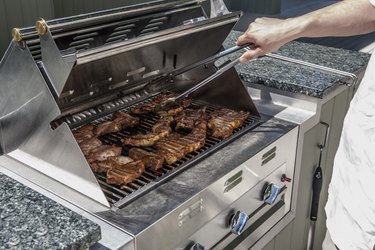As any avid gas griller will tell you, a propane tank will always run out at the least convenient moment — usually right after the store has closed or just before you've grilled an expensive steak to perfection. So why don't propane tank makers add a propane tank pressure gauge to their products? Because when it comes to propane, pressure gauges are effectively useless. There isn't a direct correlation between the amount of pressure in a tank and the amount of propane left in it.

Video of the Day
Propane Isn't Always a Gas
Inside a propane tank, you are not dealing exclusively with a gas. As you add propane gas to an empty tank, the pressure will increase. However, when the tank reaches a certain pressure, the gas begins to condense into a liquid form. If you continue to add more propane, the pressure will stay mostly the same while the level of liquid propane at the bottom of the tank increases.
Video of the Day
Propane Tanks 101
A full propane tank contains mostly liquid propane, with a pocket of propane gas at the top near the valve. When you open the valve, that gas gets pushed out by the pressure inside the tank. As the pressure in the tank decreases, some of the liquid propane will change back to a gaseous form until the pressure rises again. A propane gauge's pressure reading can give you an estimate of how much propane is in a gas form versus a liquid one, but it won't tell you how much propane remains in the tank.
Constant Cooking Pressure
The pressure inside a propane tank remains constant while you hear and smell gas coming out of the tank. The amount of liquid in the tank will decrease as that liquid changes to gas, but the pressure inside the tank won't change. If the pressure drops, more liquid changes back to a gas, increasing the pressure again. If the pressure increases, more gas turns to liquid, dropping the pressure.
When all of the liquid propane in a tank converts to gas, the pressure in the tank drops rapidly and gas stops coming out of the tank. This happens quickly, which is why propane tanks run dry without warning. If you were to add a pressure gauge to the tank, you would see that the pressure stays mostly the same while you grill or otherwise actively use your propane tank. Even with a pressure gauge could run out of propane before that juicy steak is fished.
Propane Levels by Weight
You can't judge how much propane remains in a tank using pressure, but there other ways to judge a tank's fullness. The most common method is by the weight of a tank. As the level of liquid propane increases inside a tank, so does the overall weight of the tank.
Most home grills use a 5-gallon propane tank which holds about 4.7 gallons of propane. A full 5-gallon tank weighs around 40 pounds. Twenty pounds of that weight is the tank itself. The other 20 pounds is the weight of the liquid propane.
Visual Propane Levels
If lifting a 40-pound tank full of propane seems inconvenient, you can instead opt for a visual guide. Many home improvement stores sell a long sticker or magnetic strip that attaches to the outside of the tank. Pouring near boiling water on the strip causes it to change color only where there is gas inside the tank — it will not change where there is liquid. This allows you to visually see how much liquid is left in the tank.
If you need to exchange tanks when getting a propane refill, remember to buy a magnetic version and take it off the tank before exchanging.
Propane Tank Gauge Versus Regulator
While the pressure inside a propane tank won't tell you how full it is, it still matters. Too much pressure can damage your grill and other appliances that run on propane. Too little and you won't have enough gas to accomplish your goal. Propane regulators solve both problems, using a mechanical diaphragm to maintain the proper amount of pressure.
They are a vital part of the propane system but are generally part of your grill rather than the propane tank. This means you won't get a new one with every propane tank exchange, so you must maintain this important part on your own. Inspect it before use and replace it on the manufacturer's specified timeline.
Propane Safety Tips
As a propane tank warms, the pressure inside increases and can become dangerously high. This is why you should never leave a propane tank in a hot car, store it indoors, or let it anywhere near a fire.
Instead of gauges that tell you when the pressure is high, propane tanks contain pressure release valves that take action on their own. If the pressure inside the tank gets too high, this safety valve will automatically open and release it. Never tamper with or remove this safety valve.